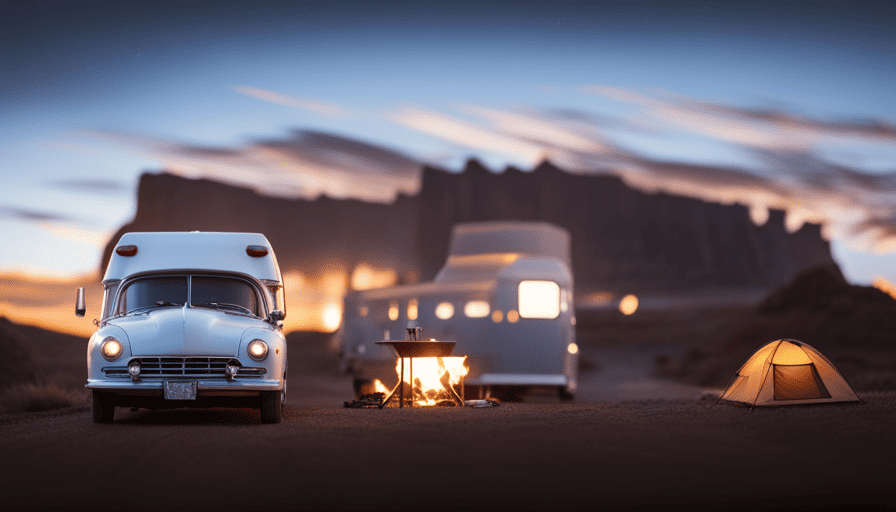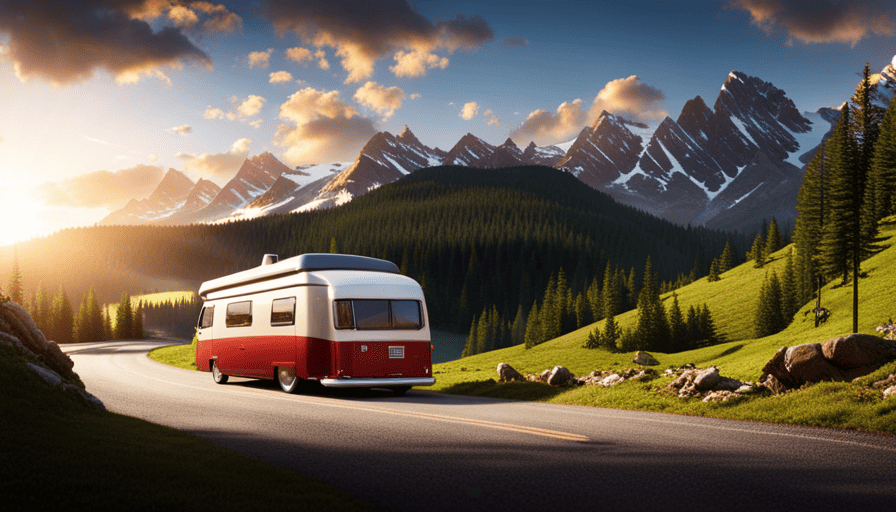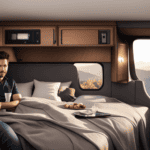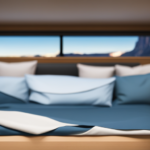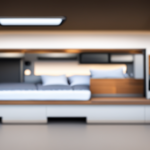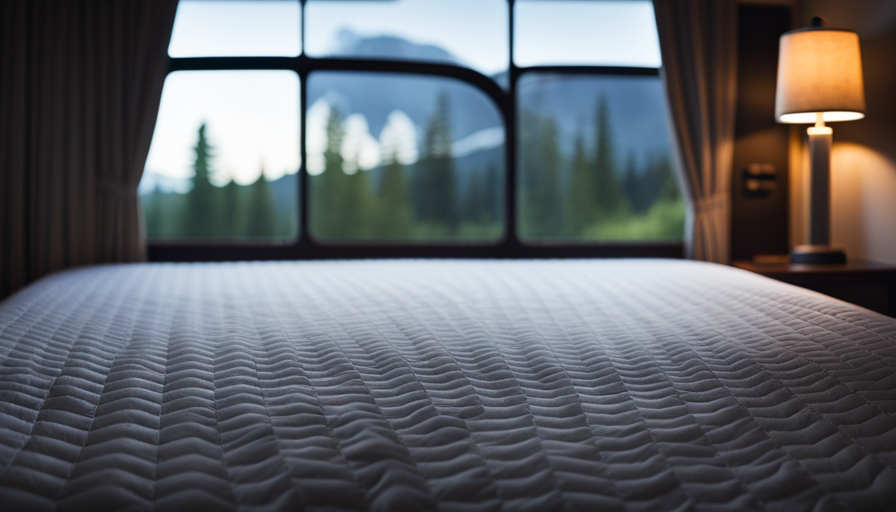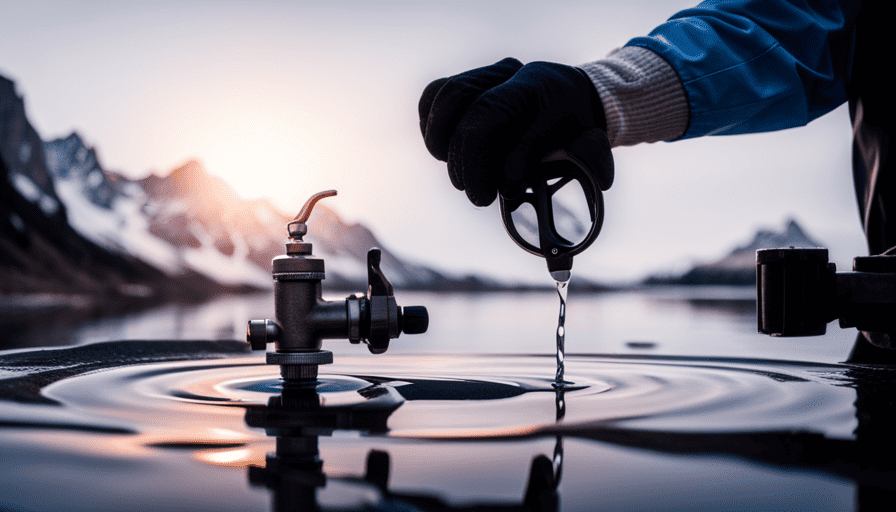Now is the moment to venture out onto the open highway for a fresh journey. Yet, why opt for an ordinary RV when you have the option to convert an ambulance into a unique mobile home?
In this article, I’ll show you how to convert an ambulance into a camper, unlocking its full potential and creating a space that’s both functional and comfortable.
With a little planning and some elbow grease, you can transform the sterile interior of an ambulance into a cozy living space that’s perfect for your road trip dreams.
We’ll start by assessing the ambulance’s potential and creating a design plan that suits your needs. Then, we’ll dive into the nitty-gritty, removing unnecessary equipment, insulating and waterproofing the interior, and installing essential features and amenities.
From comfortable furnishings to electrical and plumbing systems, we’ll cover it all.
So, if you’re ready to turn your ambulance into the ultimate camper, buckle up and let’s get started on this exciting journey together!
Key Takeaways
- Assess the condition of the ambulance and set a realistic budget for the conversion project.
- Maximize space and consider the needs of travel companions when designing the layout and features of the camper.
- Strip the interior of unnecessary equipment and fixtures, and repair or replace damaged parts for safety and functionality.
- Insulate and waterproof the interior using lightweight materials, such as closed-cell spray foam insulation, and ensure proper sealing of windows and doors to prevent leaks and drafts.
Assess Your Ambulance’s Potential as a Camper
Now, let’s take a closer look at your ambulance and see just how much potential it has to be transformed into the camper of your dreams.
Assessing the vehicle condition is the first step in converting an ambulance into a camper. Start by inspecting the overall condition of the ambulance, including the engine, transmission, and body. Look for any signs of wear and tear, rust, or mechanical issues that may require attention. It’s essential to ensure that the ambulance is in good working condition before starting the conversion process.
Next, consider your budget planning. Converting an ambulance into a camper can be a significant investment. Determine how much you’re willing to spend on the project and set a realistic budget. Consider the costs of materials, tools, and any professional help you may need along the way. It’s important to have a clear understanding of your financial limitations to avoid overspending or compromising the quality of the conversion.
Once you have assessed the vehicle condition and set a budget, it’s time to create a design plan. This will involve determining the layout, features, and amenities you want in your camper. Consider your lifestyle, the number of people it needs to accommodate, and the activities you plan to do while traveling. With a well-thought-out design plan, you can move forward in the conversion process with confidence and clarity.
Create a Design Plan
To start conceptualizing your ideal camper, begin by mapping out a detailed plan for transforming the ambulance into an inviting and functional space.
Maximizing space is crucial when converting an ambulance into a camper, as you want to make the most of the limited area available. Take measurements of the interior and consider how each area can be utilized efficiently.
Think about the different zones you want to incorporate, such as a sleeping area, kitchenette, bathroom, and storage space. Choosing the right layout is essential for ensuring a comfortable and practical living space. Consider factors like ease of movement, access to essential amenities, and overall functionality.
Sketching out different layout options can help you visualize the possibilities and make informed decisions. Additionally, think about the specific needs and preferences of your travel companions.
Once you have a solid design plan in place, you can move on to the next step of removing unnecessary equipment and fixtures, creating a clean canvas to work with.
Remove Unnecessary Equipment and Fixtures
First, I would begin by stripping the interior of the ambulance to remove any unnecessary equipment and fixtures. This would involve carefully removing items such as medical equipment, cabinets, and partitions to create a blank canvas for the camper conversion.
Next, I would assess any damaged parts and either repair or replace them as needed. This may include fixing any dents, replacing broken windows, or repairing electrical systems.
By taking these steps, I can ensure that the ambulance is ready to be transformed into a functional and comfortable camper.
Strip the Ambulance Interior
Before you can transform your ambulance into a cozy camper, you need to skillfully strip the interior. Carefully remove all traces of its former medical purpose. Start by assessing the space and determining what needs to be removed. Take out any cabinets, partitions, or fixtures that aren’t needed for your camper conversion. This will create a blank canvas for you to work with.
Repurpose materials whenever possible to save money and reduce waste. For example, you can reuse the ambulance’s metal framing to create new storage compartments or build a bed frame. Be sure to remove any medical equipment, wiring, or plumbing that isn’t necessary anymore.
Once you’ve stripped the interior, you can move on to repairing or replacing any damaged parts. Ensure that your camper is safe and functional for your upcoming adventures.
Repair or Replace Damaged Parts
Once you’ve stripped the interior, it’s time to roll up your sleeves and give those damaged parts some much-needed TLC. Repairing or replacing damaged parts is crucial in converting an ambulance into a camper.
Assess the extent of the damage and decide whether it can be fixed or if a replacement is necessary. For minor issues like cracks or dents, repairs can be done using epoxy or fiberglass. However, for major structural damage or worn-out components, it’s best to find replacement parts from salvage yards or online suppliers specializing in ambulance conversions.
Remember to prioritize safety and functionality when making these decisions. This step ensures that your camper is in top shape to withstand the rigors of the road.
With the damaged parts taken care of, it’s time to move on to the next phase: insulating and waterproofing the interior.
Insulate and Waterproof the Interior
When it comes to insulating and waterproofing the interior of your converted ambulance camper, it’s important to choose the right materials for the job. Opt for insulation that’s not only effective in regulating temperature but also lightweight and flexible to fit the unique shape of your vehicle.
Additionally, sealing windows and doors properly is crucial to prevent any leaks or drafts, ensuring a comfortable and dry living space.
Choose the Right Insulation Materials
To properly insulate your ambulance camper, you should consider using closed-cell spray foam insulation. It has an impressive R-value of 6.5 per inch and provides excellent thermal insulation. This type of insulation is ideal for camper conversions because it expands to fill all the nooks and crannies, creating a seamless barrier against heat transfer.
When choosing insulation materials, it’s important to consider factors such as moisture resistance and fire safety. Closed-cell spray foam insulation checks both of these boxes, making it a reliable choice for your camper.
Additionally, this insulation material is easy to install, especially in hard-to-reach areas. By hiring a professional or doing it yourself, you can ensure that the insulation is applied properly, maximizing its effectiveness.
Once the insulation is in place, you can move on to sealing windows and doors to prevent leaks.
Seal Windows and Doors to Prevent Leaks
Make sure you seal all the windows and doors tightly to keep out any unwanted drafts or moisture. Properly sealing your windows and doors is crucial for maintaining a watertight seal in your camper.
To fix window and door leaks in your camper, start by inspecting the existing seals for any signs of damage or wear. Replace any worn-out seals with new ones that are specifically designed for campers. Additionally, consider using a sealant around the edges of the windows and doors to provide an extra layer of protection against leaks.
Don’t forget to check the hinges and locks as well, as they can also contribute to leaks if not properly sealed. By ensuring that your windows and doors are well-sealed, you can prevent any potential leaks and keep your camper dry and comfortable.
Now, let’s move on to the next section where we will discuss how to install essential features and amenities in your converted ambulance camper.
Install Essential Features and Amenities
Transforming an ambulance into a camper is like giving it a new lease on life, as it becomes a mobile haven equipped with all the essential features and amenities. When it comes to converting an ambulance, designing the layout is key to maximizing the available space and ensuring a comfortable living area.
Start by determining the placement of the bed, kitchenette, and bathroom to ensure a functional and efficient use of space. For the bed, consider a foldable option that can be easily converted into a seating area during the day. This will allow for more space to move around when needed. A compact kitchenette can be installed with a sink, stove, and refrigerator to meet basic cooking needs. To make the most of the limited space, consider using multi-purpose furniture and collapsible items.
In terms of amenities, installing a small bathroom with a toilet and shower is crucial for convenience. Consider using space-saving fixtures and fittings to optimize the available area. Additionally, having a water tank and a power supply system is essential for self-sufficiency on the road.
With the essential features and amenities in place, the next step is to design a functional storage system that maximizes space and keeps everything organized. By utilizing clever storage solutions such as overhead cabinets, under bed storage, and hanging organizers, you can make the most of every inch of the camper.
In the subsequent section about designing a functional storage system, we will explore creative ways to keep your belongings secure and easily accessible while on the go.
Design a Functional Storage System
Creating a functional storage system ensures that all your belongings are secure and easily accessible, optimizing space in your newly transformed mobile haven. When converting an ambulance into a camper, it’s crucial to maximize space and stay organized.
Here are some practical tips to achieve an efficient storage system:
-
Utilize vertical space: Install overhead shelves or cabinets to store lightweight items such as clothing, bedding, or camping gear. This frees up valuable floor space for other essentials.
-
Invest in modular storage solutions: Opt for adjustable shelves, drawers, or bins that can be rearranged to accommodate different items. This allows for flexibility and customization based on your changing needs.
-
Use multi-purpose furniture: Choose furniture pieces that serve dual purposes, like a bench with built-in storage or a bed with under-bed drawers. This maximizes the functionality of each item and saves precious space.
-
Organize with labeled containers: Sort and categorize your belongings into clear, labeled containers. This makes it easier to find what you need quickly and keeps everything tidy.
By following these organization tips and creating a smart storage system, you’ll have a clutter-free and functional space inside your converted ambulance camper. With storage taken care of, it’s time to move on to selecting comfortable furnishings and decor to make your mobile haven truly cozy and inviting.
Choose Comfortable Furnishings and Decor
After designing a functional storage system for my converted ambulance camper, it’s time to focus on making the space comfortable and inviting.
Selecting cozy bedding is essential for a good night’s sleep on the road. I opted for a high-quality mattress that fits snugly in the available space, ensuring maximum comfort. To make the bed even cozier, I added soft pillows and a warm duvet. Additionally, I installed blackout curtains to block out any unwanted light and create a peaceful sleeping environment.
To make the camper feel more like home, I’ve been adding personal touches throughout the space. I hung up some family photos on the walls and placed a few small decorative items on the shelves. I also brought along my favorite blanket and some scented candles to create a calming atmosphere. These personal touches make the camper feel more like my own little sanctuary on wheels.
Next, I’ll be moving on to installing the electrical and plumbing systems. This step is crucial for ensuring a functional and convenient living space. By having these systems in place, I’ll be able to enjoy all the comforts of home while on the road, from running water to electricity for charging my devices.
Install Electrical and Plumbing Systems
To convert an ambulance into a camper, it’s crucial to have a well-functioning electrical and plumbing system.
First, wire the camper for electricity by installing a power inverter, connecting it to a deep cycle battery, and wiring outlets and light fixtures throughout the space.
Next, set up a water supply and plumbing by installing a freshwater tank, connecting it to a water pump, and routing pipes to a sink and shower.
These systems are essential for a comfortable and functional camper, ensuring you have power for appliances and lights, as well as a reliable water supply for cooking and cleaning.
Wire the Camper for Electricity
Surprisingly, the first step in turning your ambulance into a camper involves juggling wires to bring electricity to your dream home on wheels. To power your camper, installing solar panels is a great option for off-grid adventures. Make sure to choose the right battery that can handle the demands of your electrical system.
Deep cycle batteries are commonly used as they provide a steady flow of power over a longer period of time. Once you have your solar panels and battery, it’s time to wire your camper. Start by mapping out the electrical system, taking into consideration the placement of lights, outlets, and appliances. Use appropriate gauge wires and connect them to a fuse box for safety.
Finally, ensure that all connections are secure and protected. Now, let’s move on to setting up a water supply and plumbing for your camper.
Set Up a Water Supply and Plumbing
With a steady flow of electricity now in place, it’s time to create a functional water supply and plumbing system for your transformed mobile home. A reliable water filtration system is essential to ensure clean and safe water for drinking, cooking, and washing. Install a water pump to provide consistent water pressure throughout the camper. Connect the pump to a freshwater tank and include a water heater for hot showers and dishwashing. To manage waste water, set up a grey water tank and a separate black water tank for toilet waste. Regularly maintain the plumbing system by checking for leaks, cleaning the tanks, and replacing filters as needed. With a well-designed water supply and plumbing system, your converted ambulance will truly feel like a home on wheels. As you move forward, it’s important to test and inspect your converted camper to ensure everything is in working order.
Test and Inspect Your Converted Camper
Don’t forget to thoroughly test and inspect your converted camper to ensure it’s safe and ready for your next adventure!
After putting in all the hard work to convert your ambulance into a camper, it’s important to go through a maintenance checklist to make sure everything is in working order.
Start by checking the electrical system, including all the lights, outlets, and appliances. Test the plumbing system by running water through all the faucets and checking for any leaks or clogs.
Inspect the insulation and make sure there are no gaps or areas where cold air can seep in.
Don’t forget to inspect the tires, brakes, and suspension to ensure they are in good condition for the road.
Once you’ve completed the maintenance checklist, you can hit the road and enjoy your new camper! Just remember to drive safely and be prepared for any unexpected situations that may arise.
Hit the Road and Enjoy Your New Camper!
Now that your converted camper’s ready, you can hit the road and start enjoying your new home on wheels! Did you know that over 11 million Americans have embraced the van life and are exploring the world in their own custom campers?
When it comes to camper van travel, there are endless possibilities for adventure. Here are some of the best destinations that you should consider adding to your bucket list:
- The stunning coastlines of California, with its breathtaking views and iconic Highway 1.
- The picturesque landscapes of the Pacific Northwest, where you can explore national parks like Olympic and Mount Rainier.
- The rugged beauty of the Rocky Mountains, offering endless opportunities for hiking, camping, and wildlife spotting.
Living in a camper full time can be an incredibly rewarding experience, but it also requires careful planning and preparation. Here are a few tips to help you make the most of your new lifestyle:
- Stay organized and declutter regularly to maximize your space.
- Be mindful of your resources, such as water and electricity, and learn how to conserve them.
- Embrace minimalism and focus on experiences rather than material possessions.
So, pack your bags, choose your first destination, and embark on an unforgettable journey in your newly converted camper! The freedom and flexibility of van life await you.
Frequently Asked Questions
How much does it typically cost to convert an ambulance into a camper?
Cost considerations and budgeting tips are crucial when converting an ambulance into a camper. The total cost typically depends on various factors such as the ambulance’s condition, desired features, and personal preferences.
Expenses can include insulation, electrical systems, plumbing, furnishings, and exterior modifications. It’s essential to research and compare prices for materials, equipment, and labor.
Planning a realistic budget and prioritizing necessary expenses will help ensure a successful and cost-effective conversion process.
What are the legal requirements for converting an ambulance into a camper?
To legally convert an ambulance into a camper, there are certain requirements that must be met. The conversion process involves making necessary modifications to ensure safety and compliance with regulations. These modifications may include removing emergency equipment, installing sleeping and living quarters, and adding amenities such as a kitchenette and bathroom facilities.
It’s important to research and adhere to local laws and regulations regarding vehicle conversions to ensure a successful and legal transformation.
Can I still use the sirens and emergency lights on the ambulance after conversion?
No, it’s not legal to use the sirens and emergency lights on an ambulance after it’s been converted into a camper. Once a vehicle is no longer classified as an emergency vehicle, it must adhere to the regulations for converted campers. These regulations typically require the removal of any emergency equipment, including sirens and lights. It’s important to comply with these regulations to ensure the safety and legality of your converted ambulance camper.
How much weight can the converted camper hold?
Alright folks, let’s dive into the nitty-gritty of how much weight a converted camper can handle.
When it comes to weight capacity, it largely depends on the specific make and model of the ambulance you’re working with. However, most ambulances are built to carry heavy medical equipment, so they typically have a decent weight capacity.
As for storage options, ambulances offer plenty of compartments and cabinets to securely stow your belongings. So rest assured, you won’t have to leave anything behind on your camper adventures!
Are there any specific safety considerations when converting an ambulance into a camper?
When converting an ambulance into a camper, safety precautions are of utmost importance. One key consideration is ensuring that the insulation is properly installed to regulate temperature and prevent condensation.
It’s crucial to use fire-resistant materials and secure all items to prevent them from shifting during travel. Additionally, installing a carbon monoxide detector and a fire extinguisher is essential.
Taking these safety measures will help ensure a safe and enjoyable camping experience in your converted ambulance.
Conclusion
After weeks of hard work and dedication, I’ve successfully converted my ambulance into a camper. It’s been an incredible journey, and I’m thrilled with the end result.
One interesting statistic that really struck me during this process is that converting an ambulance into a camper can save you up to 50% compared to buying a brand new camper. This goes to show that with a little creativity and effort, you can create your dream camper without breaking the bank.
So go ahead, grab an old ambulance and embark on your own camper conversion adventure!

